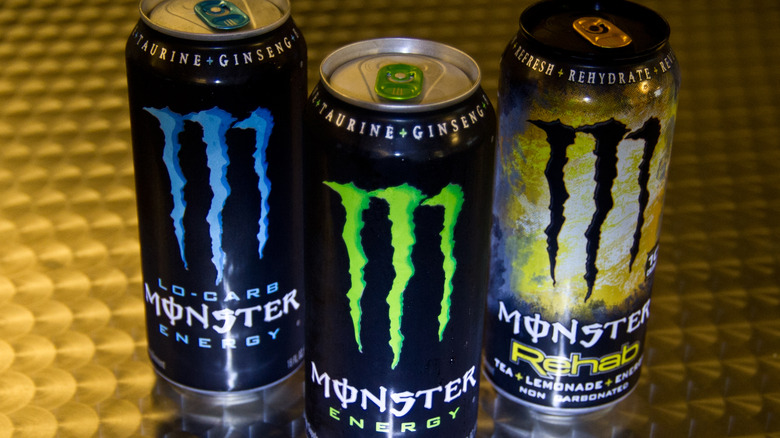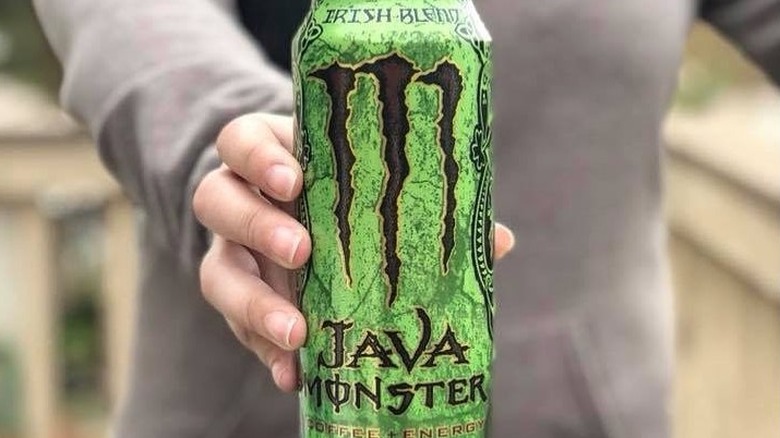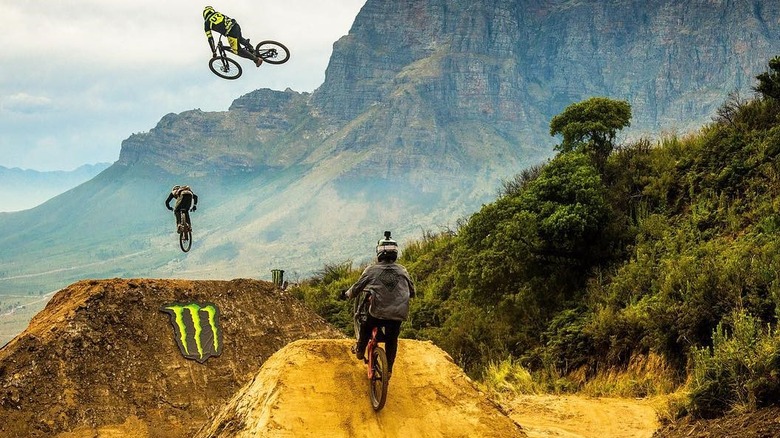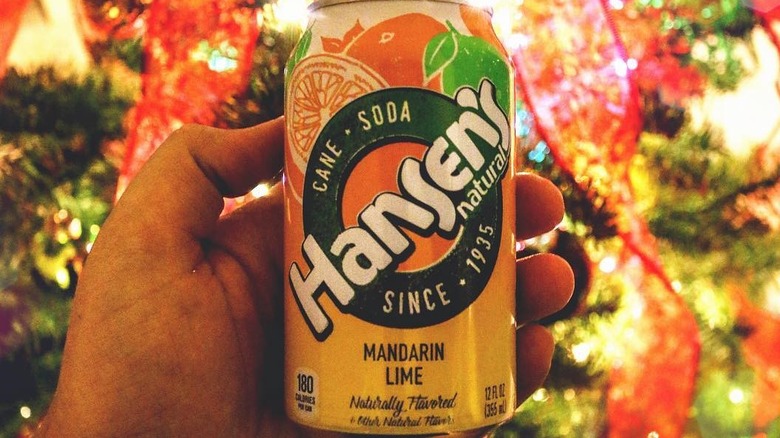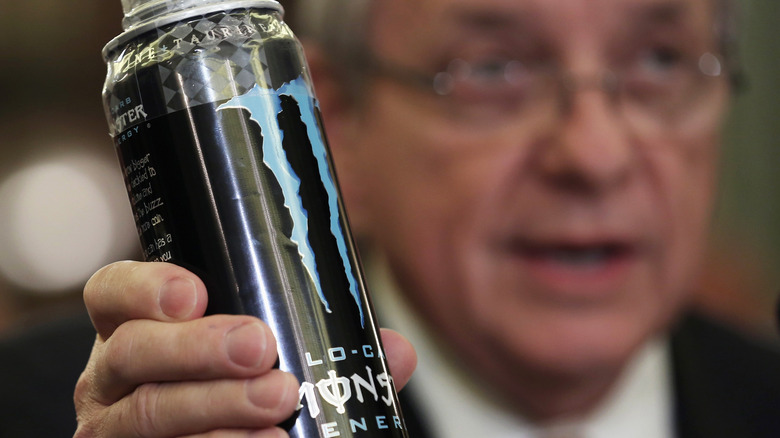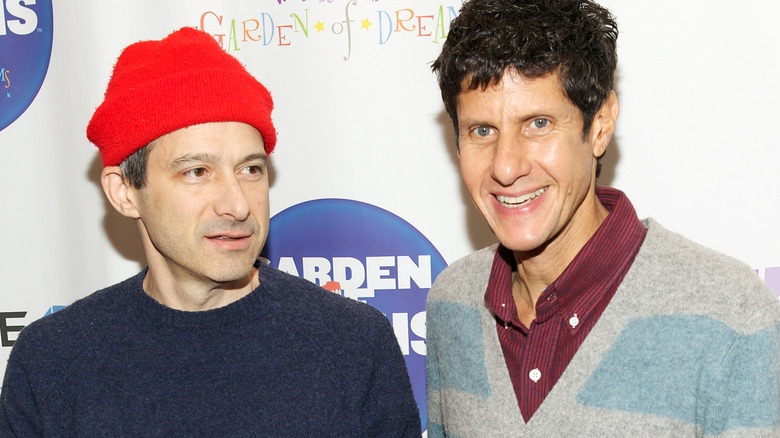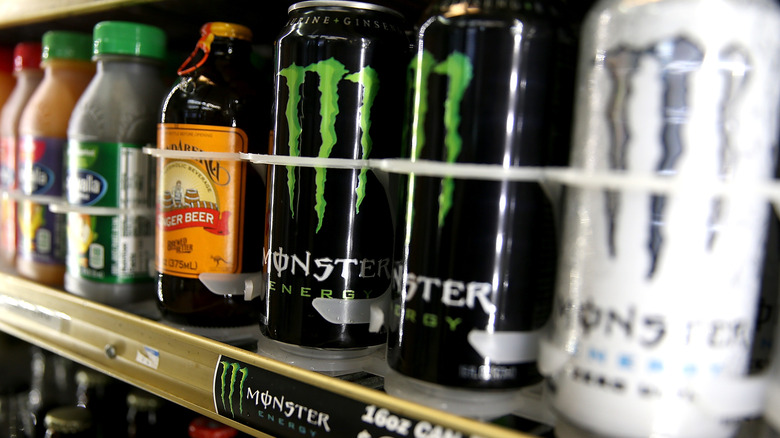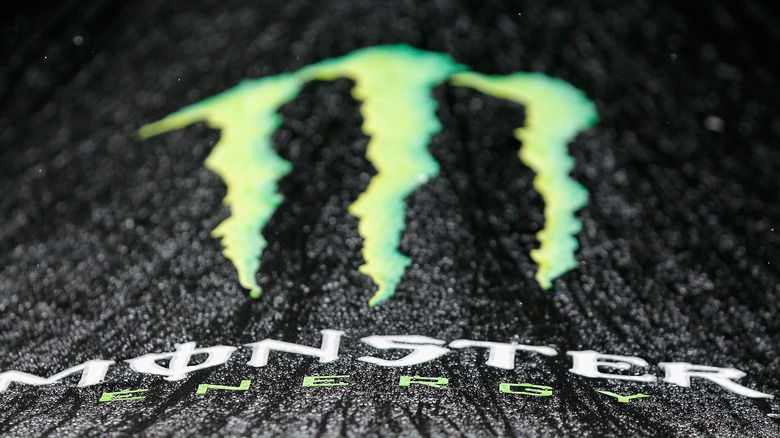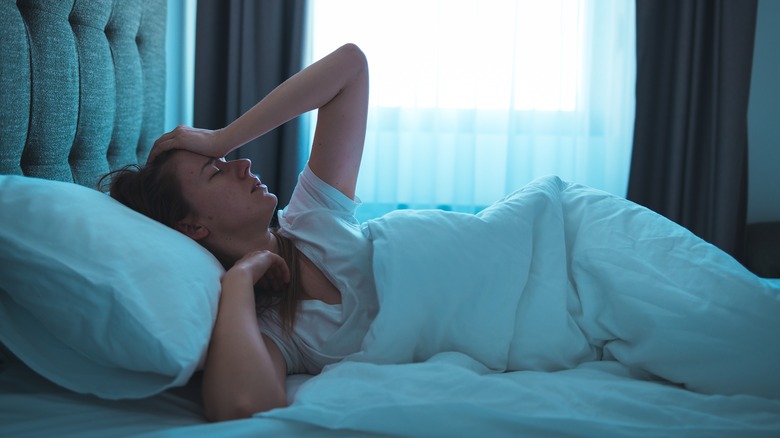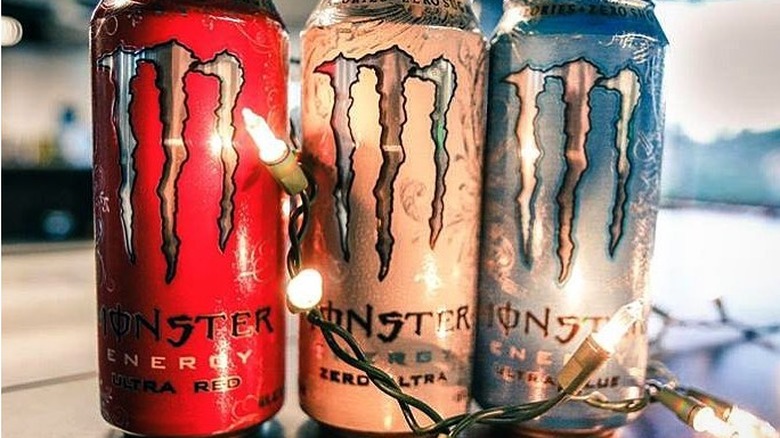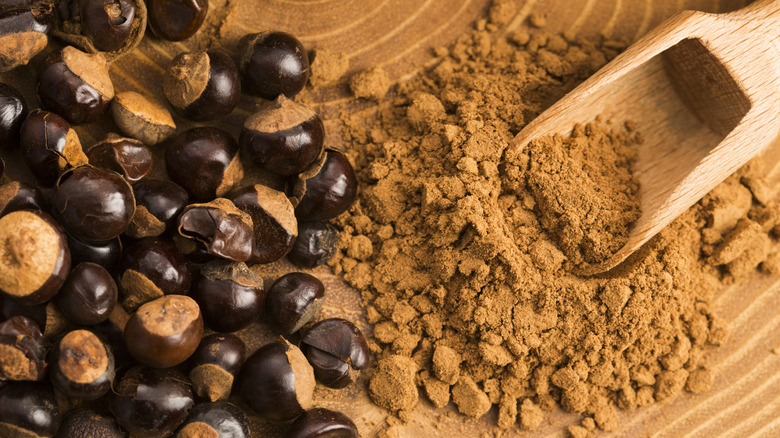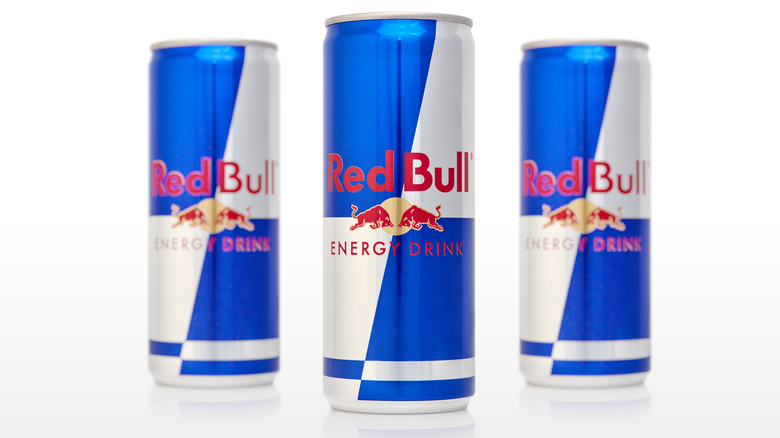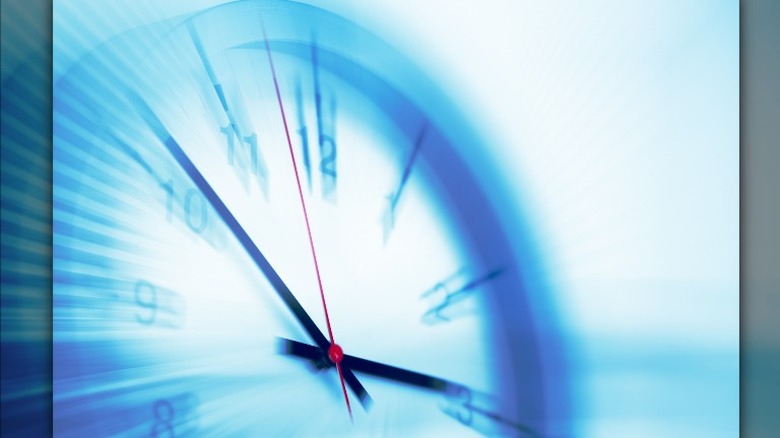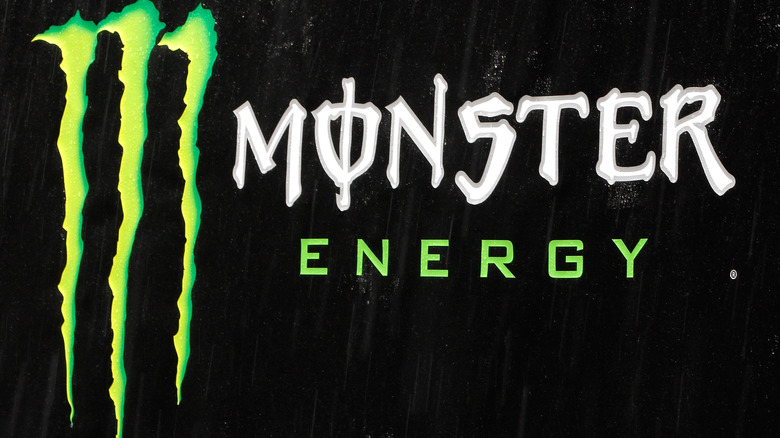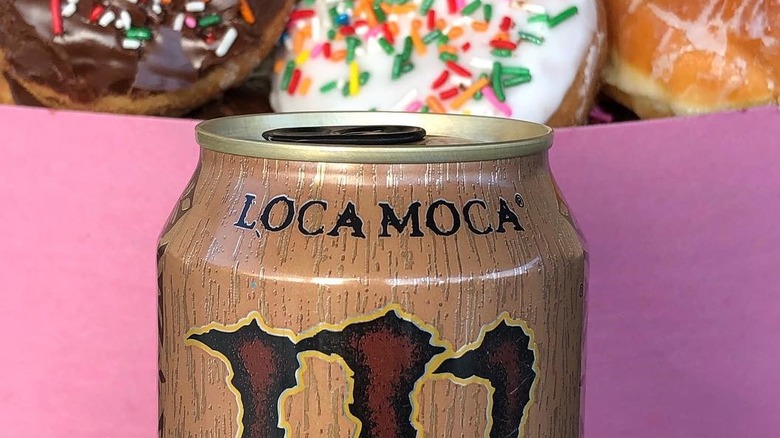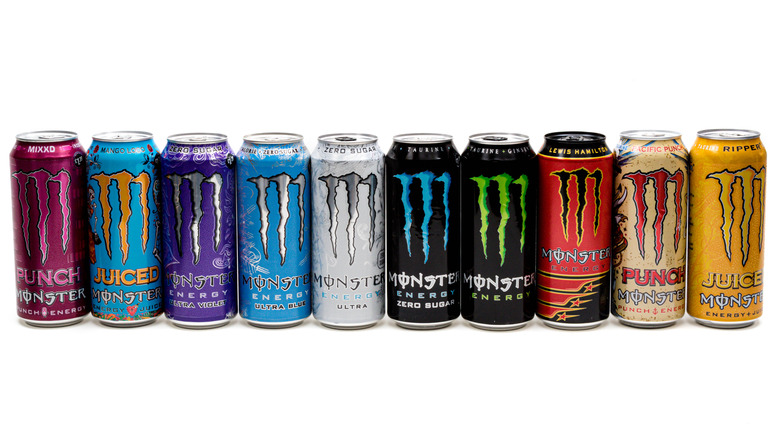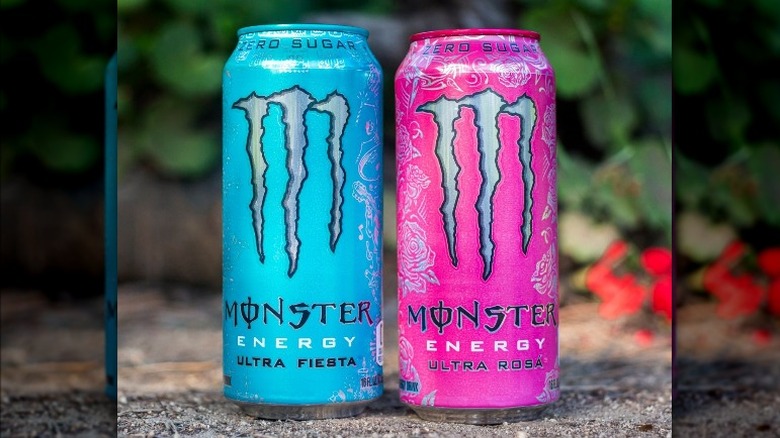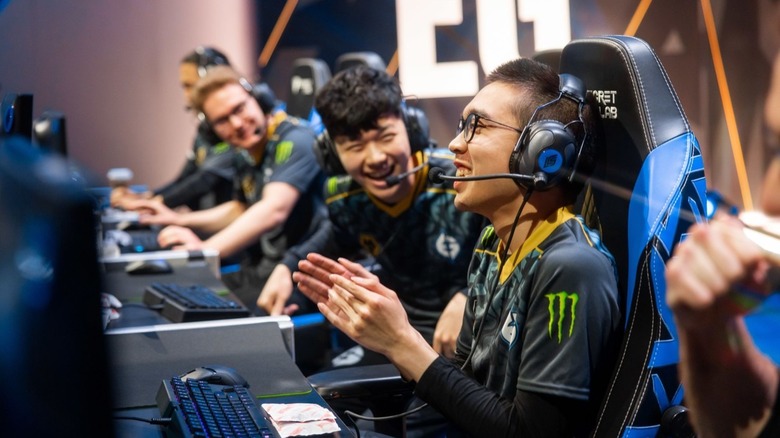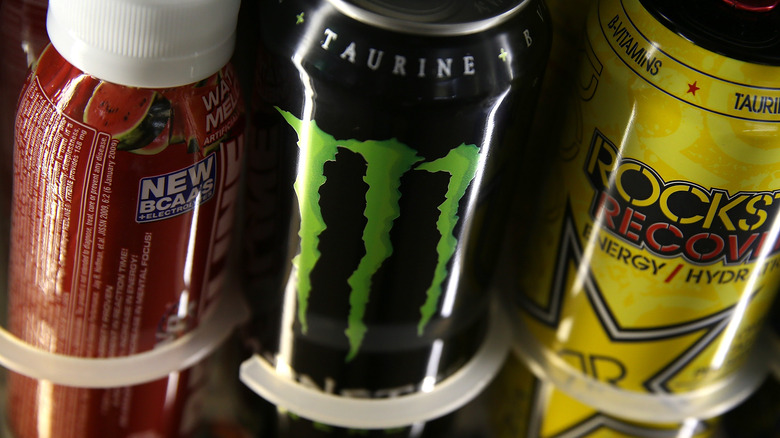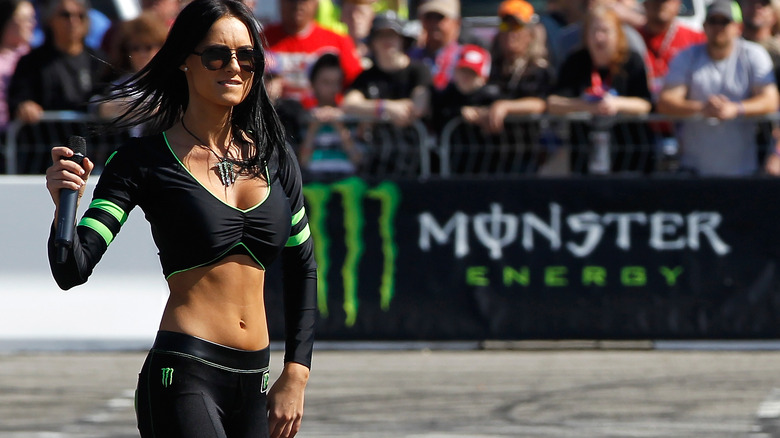Monster Energy: All The Facts About The Energy Drink
We may receive a commission on purchases made from links.
Energy drinks are everywhere, and it's easy to forget they're a fairly new phenomenon. While there are a ton of obscure brands each looking to be the next new giant, there's one titan that sits at the top of the mountain: Monster. With the help of edgy packaging and an image that went along with the name, Monster is in almost every grocery and convenience store, and it has a devoted following. It's no wonder, either.
Look at Red Bull. There's an incredibly limited number of flavors, and for the most part, the overwhelming majority of what you see on shelves is a single distinct but indescribable flavor. If you're not a fan, you're out of luck — but no matter what you like, there's a Monster for you. Like orange, grape, or lemonade? Prefer iced tea or coffee to your usual energy drink-style fizz? Monster caters to everyone, and even if you can name your favorite with hesitation, there are probably still some things you don't know about this energy-drink juggernaut.
Drinking with the Devil?
Most people just assume the concept behind Monster is just some clever marketing, but there's a conspiracy theory circulating that there's much more to the logo than just the claws of some unidentified monster we never actually get to see (but sort of want to). Those claw marks are at the heart of the theory, and it's claimed they're actually in the shape of the Hebrew vav, which represents the number six. There are three claws ... and you can probably see where this is going.
In addition to the "666," there's a ton of other satanic evidence that's supposedly been discovered on cans of Monster. That includes the design of the Monster logo's "O," which some liken to a cross that's turned upside-down every time you take a drink. There's also the slogan — Unleash the Beast — that has stirred up some hate. Needless to say, Snopes notes there's pretty much nothing to the claims in the conspiracy theory, but that hasn't stopped the story from making the rounds pretty regularly since 2009.
There was a big sponsorship dilemma
Monster isn't just about the energy drinks. It's also behind the Monster Army, a program that supports and sponsors aspiring athletes in some less-than-traditional sports, like surfing, mountain biking, and snowboarding. Selected athletes get monetary support, publicity, and guidance, with some going on to become pro athletes sponsored by the company. One of those athletes was BMX superstar Colton Satterfield ... until, that is, he announced he was leaving the company for religious reasons.
Satterfield's official statement (via Vital BMX) thanked Monster for all it had done, but also said he wasn't able to, in good conscience, continue under its sponsorship because of its marketing angle. He wrote, "The decision was not a light one by any means. I regret something seemingly so small, to some, as logos and various marketing, has to divide us; but I know it is the correct decision for me." Mormon Light reported that the response was mixed, with some supporting his decision and others having no idea what the big deal actually is.
It has all-natural roots ... believe it or not
Love it or loathe it, everyone has to admit that Monster is still pretty controversial. Ultimately, that's what makes its roots so surprising.
Monster's creator and parent brand is Hansen's Natural, which is just loaded with a whole bunch of irony. Fortune says that no matter how unlikely you might think it sounds, the truth is even unlikelier. Hansen's Natural was founded in the 1930s, and it was a family business run by Hubert Hansen and his sons. The product? Fresh fruit juices. The company got its first overhaul in the 1970s when it joined the soda market, but still stuck with the idea of an all-natural, fruit-based product. The company trundled away, making a profit but not a killing, until 2002. That's when Monster hit the shelves, and between 2003 and 2011, its annual revenue went from $50 million to $1.7 billion. That's how you know you have a winner.
The label change caused a stir
For more than a decade, Monster labels referred to their "supplement facts," leading to a bit of a strange schism. Even the U.S. Food and Drug Administration was sent scrambling, needing to define the difference between a drink that's a dietary supplement and a drink that's, well, just a drink. It's an important distinction, and changes the laws that companies need to follow.
CBS News reported it was only in 2013 that Monster revamped its labels to refer to "nutrition facts" and accepted the label of a "drink," instead of the more medical-sounding supplements, and it was only then it completely came clean about the caffeine content of each can, too. It was a big deal, especially considering that when Monster started getting big, most people hadn't even heard of things like guarana, panax ginseng, taurine, and niacin, all ingredients found in most energy drinks (and we took a closer look at each of them in this article).
In case you're wondering what sort of mess the whole "traditional drink vs. dietary supplement" really was, consider this: While Monster was a dietary supplement, Red Bull was a traditional drink. And, as backwards as it might seem, traditional drinks are more regulated than dietary supplements. Strange? Absolutely.
The Beastie Boys are definitely not fans
Monster and the Beastie Boys seem like a logical match, but that's definitely not the case. In 2014, Rolling Stone reported on an ongoing lawsuit that's honestly one of the stranger ones you've probably heard.
It started when Monster sent DJ Z-Trip a rough cut of a Beastie Boys megamix recorded from one of the DJ's sets at a Monster-sponsored festival. Z-Trip's response — "Dope!" — led Monster employees to think they absolutely had permission to put the video on their website, but the DJ later came back and said that's not what he meant at all, he'd only meant he liked it. The following legal case debated the meaning of the world "Dope!" and whether or not use of the music made it look like the Beastie Boys supported Monster. The Beastie Boys were awarded $1.7 million, but they weren't done yet. Rolling Stone said they were back in court the following year, looking for an additional $2.4 million to cover their legal fees. It wasn't settled until January 2016, and Reuters says the final settlement was undisclosed.
They're banned in India — for a weird reason
Head off to India for a vacation, and be forewarned: You're not going to find Monster there waiting to give you a much-needed pick-me-up. They're banned, and it's for a weird reason.
In 2015, The Telegraph India reported Monster Energy was ordered to cease production and sales in India (along with Cloud 9 and Tzinga). The reason? The drinks just didn't make any sense.
They included both caffeine, which is a stimulant, and ginseng, which is a popular ingredient in traditional medicines that has the exact opposite effect as a stimulant. Those conflicting ingredients were the reason given for the ban, with the official decree describing the combination was "irrational and impermissible." Caffeine alone, on the other hand, was noted to be generally considered safe, but the levels of caffeine in Monster (and other energy drinks) warranted some more research. That was found to be especially true, says Down to Earth, when testing seemed to suggest as many as 38% of energy drinks tested (including Monster) contained higher levels of caffeine than what was disclosed on the label — a label which India also took issue with, calling it misleading.
There's an age limit in the U.K.
It wasn't until 2018 that most U.K. supermarkets officially banned the sale of Monster (and other energy drinks) to anyone under the age of 16. According to The Guardian, the ban was completely voluntary and was announced by supermarkets like Tesco, Sainsbury's, Waitrose, Aldi, and Lidl.
Even though Monster carries a warning that it's not recommended for children, teens and children accounted for the majority of U.K. sales at the time of the ban. As such, it's not entirely surprising the drink is targeted by health crusaders (including the watchdog charity Action on Sugar), or that it's blamed for things like kids who act out in class.
The ban comes on the heels of another U.K. initiative designed to make drinks healthier: the sugar tax. While many drink manufacturers lowered the sugar content of their drinks to keep from raising their prices for the government-instituted tax (via the BBC), Just Drinks reported that among the last brands containing so much sugar they'd be susceptible to the tax were Coca-Cola Classic and Monster.
The side effects of drinking Monster Energy can be severe
As helpful as a Monster Energy can be after a long night or during that mid-afternoon slump, you shouldn't consistently rely on energy drinks if you value your health. According to the National Institutes of Health, scientific evidence proves that the consumption of energy drinks can have serious adverse health effects. Children, teenagers, and young adults are particularly susceptible.
The primary culprit is the excessive amounts of caffeine found in these beverages. Caffeine has been linked to a variety of physical and mental health issues, including anxiety, sleep and digestive problems, and dehydration.
Most concerning, however, is the effect energy drinks can have on your heart. The U.S. Centers for Disease Control and Prevention reports that these beverages can cause heart complications such as irregular heartbeat and even heart failure. These issues of the heart showcase why energy drinks can be worse for you than a cup of caffeinated coffee. According to the authors of a study published in the Journal of the American Heart Association, it may be the additional ingredients in energy drinks, not the caffeine, that disrupt your heart. Their study tested two groups of healthy people after they each consumed 320 mg of caffeine. Half the group consumed the caffeine via energy drinks, half from a control drink. Those who had the energy drinks were found to have significantly irregular heartbeats and higher blood pressure than those who drank the control drink.
There have been many injury and death lawsuits
In 2016, The Daily Beast took a look at the round-up of death- and injury-related lawsuits filed against Monster, and it was quite the list.
There's John Staten, who suffered a stroke in 2012 after drinking three 24-ounce cans of Monster a day over a three-month period. He was 14. Anais Fournier was 14 years old in 2012, too, and that's when she went into cardiac arrest after downing two 24-ounce cans in a single day. Fournier — who had a pre-existing heart condition — tragically died after the incident. In 2013, 19-year-old Alex Morris died of cardiac arrhythmia his mother blamed on his two-a-day Monster habit, a habit he'd had for three years.
More followed. Joel Rine sued after he says his habit of drinking six cans a day led to a stroke, and in 2014, Robert Grim was diagnosed with stage four kidney disease he blamed on his 10-year-long habit of drinking around four cans a day. For their part, Monster denies responsibility, and Popular Science agrees ... sort of. It says that so-called caffeine toxicity isn't well understood, but adds it's usually caffeine acting in conjunction with other factors that causes problems, not caffeine on its own.
Some ingredients probably do nothing
Take a gander at Monster's list of energy-giving ingredients, and it's pretty impressive. There's caffeine, which we all know about, and then there are a ton of B vitamins and what it calls its "Energy Blend." It's supposed to give energy, sure, but does it?
Not all the ingredients might, according to Forbes. Taurine is a naturally occurring amino acid, and while it might regulate energy levels, it doesn't necessarily give you a boost. Our research found that the Canadian Institutes of Health Research found there might be other benefits to taurine — like helping to prevent heart disease — but energy? Not as much as you might think.
Guarana (pictured) is a legitimate stimulant, and it's even more effective than caffeine. But then, take a look at L-carnitine. That might give you a burst of fat-burning power, but it's also got a whole host of controversies attached to it. Drink too much, and you might affect fertility levels or start to smell slightly fishy ... although if you're partaking in Monster at a sane and responsible rate, there's not enough in there to be dangerous. Or, perhaps, to give you that energy you're looking for.
Monster has more calories, sugar, and caffeine than Red Bull
A trip to any convenience store is a reminder of the plethora of energy-drink options available on the market today. Yet amongst all these competitors, two have separated themselves from the pack in terms of popularity. According to Caffeine Informer, sales of Red Bull and Monster Energy in the United States are each more than triple those of the third-place beverage, Bang Energy. This begs the question: How do the two leading energy drinks stack up against each other?
Well, when it comes to which will give you more energy, the answer is clear. According to Healthline, Monster has 10 more milligrams of caffeine than Red Bull and an additional gram of sugar, per 8.4 ounces. But remember, Monster is typically sold in 16-ounce cans, so in practical terms, its totals should be doubled. Monster also contains guarana, ginseng root, and L-carnitine, which can help bump up energy levels.
But that additional juice in each can does come with some consequences: more calories. A can of Monster packs roughly 240 calories, while a Red Bull will set you back only about 110.
The energy boost from Monster drinks peaks after about an hour
Now that we know Monster has more caffeine, it's safe to assume it provides a longer supply of energy, right? Not so fast. According to the makers of Super Coffee, extra caffeine gives you more energy, not longer-lasting energy. Caffeine, regardless of how much is in your system, is always cleared from your bloodstream at the same rate. Its half-life is roughly five hours, meaning it's usually completely out of your system within 10 hours.
But you won't be relishing the energy boost for nearly that long. You begin feeling the effects of caffeine about 10 minutes after consumption. You'll experience a peak in energy within 15 to 45 minutes as caffeine levels in your bloodstream reach their max, and the caffeine gets fully absorbed by your body within 30 to 50 minutes (via Medical News Today). After that, caffeine levels begin to drop.
About an hour after drinking a Monster Energy (or any sugary energy drink), you'll also experience a sugar crash. You may still feel some extra energy for another hour or two, but the drop in both caffeine and blood sugar will cause the drink's effects to diminish quickly. So, if you need a ton of energy for the next hour, Monster may be the right choice. But if you're looking for a boost to last you the rest of the day, Monster isn't much better than any other caffeinated drink.
There have been some wild trademark lawsuits
In 2016, the Chicago Tribune reported on Monster's dubious record: It had filed more cases with the U.S. trademark courts than any other company. It takes its trademark very, very seriously, which is fine. But it has also taken it to extreme levels.
It has sued a craft brew house in Ohio for naming a beer the "Beast from the East," it sued a Mexican restaurant over its "Monster Kong Nachos," and it even sued a winery called Dassault Wine Estates for treading too close to the name of its Monster Assault. It has even sued a group of fish enthusiasts called MonsterFishKeepers, an online forum used to discuss its love of keeping large and exotic fish.
Li Chih, the domain's owner, didn't roll. Instead, he reached out the Suffolk University Law School, where students take cases pro bono. The forum spent years defending its case in court, and it won. The verdict was kind of hilarious, and the courts decided that in Chih's case, using the word "Monster" in front of "FishKeepers" made it pretty clear no one was going to confuse the group of aquarium enthusiasts with energy drinks.
Jamie Oliver really hates them
Say what you like about Jamie Oliver, he's definitely opinionated, and no one can take that away from him. When Good Morning Britain asked him about energy drinks, he called them "a prolific problem that's hurting kids," and condemned the fact there were no age limits on who could walk into a store and "load up" with a Monster. He claimed it was such a problem that around 13% of British children averaged a daily caffeine intake equal to 14 espresso shots. Other, more official numbers agreed to a point, and according to the European Food Safety Authority (via LadBible), 69% of teens and 24% of under-10s did drink energy drinks.
And it's complicated. In 2015, The New York Times looked at just how young Monster's target audience was and said its campaign to target young gamers was particularly problematic. It added Monster claimed to have voluntarily stopped any attempts to target anyone younger than 12, but Monster has even found itself in court over its marketing practices, facing a civil suit in 2013.
There are 60 Monster drink varieties
Monster's product line is monster-sized. Altogether, it includes eight different drink segments: Monster Energy, Monster Ultra, Java Monster, Juice Monster, Monster Hydro, Rehab Monster, Dragon Tea, and Muscle Monster. Each of these drinks has between two and 12 available flavors. Add it all up, and you get 60 different drink varieties boasting the Monster label.
Among all these options, one drink reigns supreme. According to Caffeine Informer, the original Green Monster flavor is the most popular. In fact, it's the second-most popular energy drink in general, sitting only slightly behind the original Red Bull variety in terms of U.S. sales.
While consumers may opt for a single can of the original Monster variety when stopping by the gas station or grocery store, they favor a different flavor when buying online in bulk. The brand's best-selling drink on Amazon in early November 2022 was a 24-pack of Monster Energy Zero Ultra. This is followed by the original Green and Monster Rehab Tea + Lemonade. All three are among the top 10 best-selling energy drinks on Amazon. Other Monster varieties cracking the top 50 include Juice Pipeline Punch, Java Monster Mean Bean, Zero Sugar, and Lo-Carb.
Monster Ultra doesn't contain any sugar
Have you craved the energy of a caffeinated drink without the calories from the sugar that came along with it? You're not alone. In 2012, Monster expanded its product line with the introduction of Monster Energy Zero Ultra (via Beverage Daily). The zero-calorie, zero-sugar energy drink was apparently exactly what consumers wanted. Zero Ultra quickly became the company's second best-selling product, tailing only the Original Monster Green.
Monster credited the new drink's more broadly appealing taste for its popularity. "We were able to come up with a flavor profile that clearly has appealed across a lot of categories and not simply to the diet drinker," Monster Beverage CEO Rodney Sacks said in 2013. "[Ultra is] lighter and more drinkable and probably more on a soft drink vein than the traditional energy drinks."
After the original flavor's mammoth success, Monster unveiled a second zero-sugar drink, Ultra Blue, the following year. Since then, the Ultra line has expanded significantly. There are now a dozen different flavors to choose from, including Fiesta Mango, Watermelon, and Peachy Keen.
Monster got into the esports game
In 2011, Monster dipped its toes into the esports world by partnering with Evil Geniuses, one of the leading organizations in the gaming industry (via PR Newswire). After a successful 10-year run, the two companies renewed their partnership with a multi-year sponsorship extension. "We've loved growing with Evil Geniuses in the world of esports over the last 10 years and look forward to continuing leveling up together," Monster Energy's CMO Dan McHugh said.
But Evil Geniuses was just the start of Monster's venture into the esports world. In 2016, the energy-drink company began sponsoring Tim "Tim the Tat Man" Betar and Jaryd "Summit1G" Lazar, Twitch gamers who garner tens of thousands of daily viewers. Two years later, Monster welcomed the Australian team Mindfreak into its gaming family. This marked the drink manufacturer's first foray into the Australian esports world (via Esports Insider). Most recently, in March 2022, Monster extended and expanded its partnership with ESL Gaming, the world's leading esports company that operates several gaming tours and competitions (via PR Newswire).
Monster is such a mainstay in the esports world that it even crossed over into a game itself when cans of Monster Energy appeared in "Death Stranding." According to Screen Rant, players could drink them to regain stamina. The beverage's turn in the spotlight was short-lived, however, when Monster drinks were replaced in the director's cut version of the game with a generic drink (via Game Rant).
There were claims of harassment and abuse
In early 2018, Monster found itself on the receiving end of a lawsuit. This time, it was over sexual discrimination and a culture of abuse fostered by the company's executives. Huffington Post says there's a whole list of claims in the charges filed by a group of women, and it's serious stuff.
One former employee charged that her ex-boyfriend was allowed to keep his job with the company even after he tried to kill her and was arrested on charges of assault. Another employee claimed that after she started dating one of Monster's executives, she was promoted twice, then threatened with termination if she ever decided to break up with him. She went to HR when he turned abusive and was fired.
Jamie Leigh Hogan, a former regional manager, described the environment like this: "It's a guys' club and you have to be able to hang. You have to put up with some things." Those things, the lawsuits claim, involve unwanted hugging and touching, derogatory comments, and outright hostility.
Their controversial Girls
There's a lot that's pretty controversial about Monster, and right at the forefront of the controversy are the Monster Girls. In a nutshell, they're scantily clad women who travel to various sports and events to get some attention for Monster, and they're not always a popular addition to the events they go to. When they first showed up on the track at NASCAR events (after Monster took over sponsorship from Sprint), USA Today said the reaction was definitely mixed, with a good portion of social media suggesting this is one tradition that should be left in the Stone Age. They also spoke to some of the women, like Morgan Abel. The Indiana nurse-by-day, Monster-Girl-by-night says she was shocked at the hate they got, while colleague Mariel Lane added, "It's almost as if we're only here for show, but we're human beings."
Regardless, the Monster Girls did kick-start a conversation in the Orlando Sentinel, asking if it was about time to end the tradition of NASCAR grid girls, much like Formula 1 already has. Reporter David Whitley wrote, "Parading women around as sex objects might not be the ideal way to promote respectful behavior toward them."
